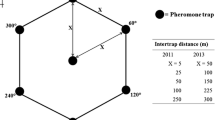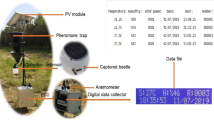Abstract
In a spindle-tree apple orchard, sex pheromone traps for the summerfruit tortrix moth were distributed at different spacings. From the captures, information was derived about influence of prevailing wind direction and of trap spacing on interactions between traps. Prevailing wind direction in the experimental area had no appreciable influence on trap interaction, perhaps because of eddying within the planting. The relationship between density and capture of traps was first considered theoretically and interaction by overlap of active-space areas was distinguished from that by overlap of mere capturing areas, which depend also on distance of dispersal. The actual results were in accordance with these considerations and indicated that the diameter of the active-space areas averaged 15 m. The variation in the captures of the wider-spaced traps was too large to be conclusive about the average width of the capturing areas, but the diameter of these seemed to be more than about 45 m. These data have been related to adequate trap distances for monitoring and mass trapping.
Similar content being viewed by others
References
Aylor, D.E. 1976. Estimating peak concentrations of pheromones in the forest, pp. 177–188,in J.F. Anderson and M.K. Kaya (eds.). Perspectives in Forest Entomology. Academic Press, New York.
Barel, C.J.A. 1973. Studies on dispersal ofAdoxophyes orana F.v.R. in relation to the population sterilization technique. Thesis, Meded. Landbouwhogeschool Wageningen 73-7, 107 pp.
Embody, D.R. 1971. Possible methods for measuring the effective range of the sex-lure trap for pink bollworm. U.S. Department of Agriculture, ARS 82–43.
Farkas, S.R., andShorey, H.H. 1974. Mechanisms of orientation to a distant pheromone source, pp. 81–95,in M.C. Birch (ed.). Pheromones. North-Holland Publishing Company, Amsterdam.
Karandinos, M.G. 1974. Recovery ofSynanthedon pictipes males released at various distances downwind of sex pheromone traps.Environ. Entomol. 3:923–925.
Kennedy, J.S., Ludlow, A.R., andSanders, C.J. 1980. Guidance system used in moth sex attraction.Nature 288:475–477.
Kennedy, J.S., Ludlow, A.R., andSanders, C.J. 1981. Guidance of flying male moths by wind-borne sex pheromone.Physiol. Entomol. 6:395–412.
Kishaba, A.N., Toba, H.H., Wolf, W.W., andVail, P.V. 1970. Response of laboratory-reared male cabbage looper to synthetic sex pheromone in the field.J. Econ. Entomol. 63:178–181.
Lewis, T., andMacaulay, E.D.M. 1976. Design and elevation of sex-attractant trap for pea moth,Cydia nigricana (Steph.) and the effect of plume shape on catches.Ecol. Entomol. 1:175–187.
McNally, P.S., andBarnes, M.M. 1981. Effects of codling moth pheromone trap placement, orientation and density on trap catches.Environ. Entomol. 10:22–6.
Minks, A.K. 1975. Biological aspects of the use of pheromones in integrated control with particular reference to the summerfruit tortrix moth,Adoxophyes orana. C.R. 5e symp. Lutte integréé en vergers. OILB/SROP, 1975, pp. 295–302.
Minks, A.K., andDe Jong, D.J. 1975. Determination of spraying dates forAdoxophyes orana by sex pheromone traps and temperature recordings.J. Econ. Entomol. 63:370–373.
Minks, A.K., andNoordink, J.Ph.W. 1971. Sex attraction of the summerfruit tortrix moth,Adoxophyes orana: Evaluation in the field.Entomol. Exp. Appl. 14:57–72.
Minks, A.K., andVoerman, S. 1973. Sex pheromones of the summerfruit tortrix moth,Adoxophyes orana: Trapping performance in the field.Entomol. Exp. Appl. 16:541–549.
Minks, A.K., Noordink, J.Ph.W., andVan Den Anker, C.A. 1971. Repacture by sex traps ofAdoxophyes orana, released from one point in an apple orchard.Meded. Rijksfak. Landbouwwet. Gent 36:274–282.
Nakamura, K. 1976. The active space of the pheromone ofSpodoptera litura and the attraction of adult males to the pheromone source. Proceedings of a Symposium on Insect Pheromones and their Applications, Nagoaka and Tokyo, 1976, pp. 145–155.
Riedl, H., andCroft, B.A. 1974. A study of pheromone trap catches in relation to codling moth (Lepidoptera: Olethreutidae) damage.Can. Entomol. 104:1661–1664.
Shorey, H.H. 1976. Animal Communication by Pheromones. Academic Press, New York. 167 pp.
Toba, H.H., Kishaba, A.N., Wolf, W.W., andGibson, T. 1970. Spacing of screen traps baited with synthetic sex pheromone of the cabbage looper.J. Econ. Entomol. 63(1): 197–200.
Vollaard, P. 1975. Unpublished results.
Wall, C., andPerry, J.N. 1978. Interactions between pheromone traps for the pea moth,Cydia nigricana (F.)Entomol. Exp. Appl. 24:155–162.
Wall, C., andPerry, J.N. 1980. Effects of spacing and trap number on interactions between pea moth pheromone traps.Entomol. Exp. Appl. 28:313–321.
Wolf, W.W., Kishaba, A.N., andToba, H.H. 1971. Proposed method for determining density of traps required to reduce an insect population.J. Econ. Entomol. 64:872–877.
Author information
Authors and Affiliations
Additional information
Lepidoptera: Tortricidae.
Rights and permissions
About this article
Cite this article
Van Der Kraan, C., Van Deventer, P. Range of action and interaction of pheromone traps for the summerfruit tortrix moth,Adoxophyes orana (F.v.R.). J Chem Ecol 8, 1251–1262 (1982). https://doi.org/10.1007/BF00987758
Received:
Revised:
Issue Date:
DOI: https://doi.org/10.1007/BF00987758




